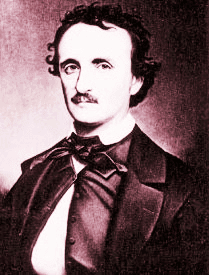Detailed Summary: Tis the Wind and Nothing More | English Reader New Gems Class 6 PDF Download
| Table of contents |

|
| About the Poet |

|
| Key Points of the Poem |

|
| Detailed Summary |

|
| Theme/ Message |

|
| Difficult Words |

|
About the Poet
EDGAR ALLAN POE (1809-1849) was a famous American writer, known for his unique and dark style. He wrote many stories and poems, but he is especially remembered for his tales of mystery and horror. Poe's works often explore deep feelings about death, loss, and sadness. His poetry has a special quality that makes readers feel the emotions he writes about. Poe's life was also filled with tragedy, which influenced his writing. One of his most famous poems is "The Raven," which is loved by many people for its haunting beauty and powerful themes.

Key Points of the Poem
- "The Raven" is a narrative poem that has 18 stanzas.
- The story centers around a man who is sad and lonely, mourning the loss of a woman named Lenore.
- As he sits in his room, a raven visits him and brings a message that deepens his sorrow.
- The poem explores themes of grief, memory, and the search for meaning in loss.
- The atmosphere is dark and eerie, creating a sense of mystery and dread.
Detailed Summary
Stanza 1
Once upon a midnight dreary, while I pondered, weak and weary,
Over many a quaint and curious volume of forgotten lore—
While I nodded, nearly napping, suddenly there came a tapping,
As of some one gently rapping, rapping at my chamber door.
“’Tis some visitor,” I muttered, “tapping at my chamber door—
Only this and nothing more.
In this first stanza, the poet begins by setting a dark and spooky scene. It is midnight, which is a time when everything is quiet and mysterious. The poet feels tired and weak, suggesting he has been thinking deeply about something for a long time. He describes reading old books, which are interesting but also forgotten, like stories nobody talks about anymore. While he is almost falling asleep, he suddenly hears a soft knocking sound. It’s like someone is gently tapping on his door. At first, he thinks it’s just a visitor and tries to convince himself that it is nothing special, saying, “Only this and nothing more.” This shows that he is trying to stay calm, even though the strange tapping might be making him a bit anxious.
Stanza 2
Ah, distinctly I remember it was in the bleak December;
And each separate dying ember wrought its ghost upon the floor.
Eagerly I wished the morrow;—vainly I had sought to borrow
From my books surcease of sorrow—sorrow for the lost Lenore—
For the rare and radiant maiden whom the angels name Lenore—
Nameless here for evermore.
In this stanza, the poet remembers that it was December, a cold and dark month when many things seem sad and lifeless. He describes the fire in his fireplace, where the last glowing pieces of wood are burning out, casting ghostly shadows on the floor. This imagery creates a feeling of gloom and sadness. He wishes for the next day to arrive, hoping that it will bring him some happiness. He tries to escape his sadness by reading books, but he realizes that it doesn’t help; he is still sad about someone named Lenore. Lenore is a special girl that he has lost, and he refers to her as “rare and radiant,” meaning she was very beautiful and precious. He feels that because she is gone, she will remain nameless and forgotten in his life forever, highlighting his deep sense of loss.
Stanza 3
Deep into that darkness peering, long I stood there wondering, fearing,
Doubting, dreaming dreams no mortal ever dared to dream before;
But the silence was unbroken, and the stillness gave no token,
And the only word there spoken was the whispered word, “Lenore?”
This I whispered, and an echo murmured back the word, “Lenore!”
—Merely this and nothing more.
In this stanza, the poet describes how he stands in the darkness, feeling scared and curious. He starts to think about many things that are strange and frightening, things that no one else has ever thought of before. The silence around him feels heavy, and he notices that there is no sound or sign of anything happening. He feels lonely and begins to whisper the name “Lenore” softly, hoping to hear her voice or feel her presence again. When he whispers her name, he hears an echo come back, repeating “Lenore!” This moment is very powerful because it shows how much he misses her. The echo makes him realize that even though he is calling out for her, she is still not there, leaving him with a feeling of emptiness.
Stanza 4
Back into the chamber turning, all my soul within me burning,
Soon again I heard a tapping somewhat louder than before.
“Surely,” said I, “surely that is something at my window lattice;
Let me see, then, what thereat is, and this mystery explore—
Let my heart be still a moment and this mystery explore;—
’Tis the wind and nothing more!
In the final stanza provided, the poet turns back into his room, feeling a strong emotion inside him, like his soul is burning with curiosity and fear. He hears the tapping sound again, but this time it is louder, which makes him feel more anxious. He starts to think that maybe the sound is coming from his window. He wants to find out what is causing this noise, hoping to understand the mystery of it. He tells himself to calm down for a moment so he can figure it out. However, he tries to comfort himself by thinking it might just be the wind, as if to say that there is nothing to be worried about. This shows his struggle between fear and calmness, which is a big theme in the poem.
Theme/ Message
Theme
- Grief: The poem powerfully expresses the pain of losing someone loved. The main character is deeply sad about Lenore, who is gone forever.
- Memory: The poem shows how memories can haunt a person. The memory of Lenore does not leave the narrator, affecting his thoughts and feelings.
- Despair: The mood of the poem is very dark. It illustrates how despair can take over someone’s life when they lose hope.
- Supernatural Elements: The presence of the raven symbolizes a connection to the supernatural, suggesting that the narrator is not alone in his sorrow.
- Isolation: The setting is lonely; the narrator is isolated both physically and emotionally, which emphasizes his sorrow.
Message
- The weight of sorrow: The poem teaches that grief can be heavy and difficult to carry. It shows how the loss of a loved one can affect a person deeply.
- Seeking answers: The narrator seeks answers about his loss and the meaning of life, but he finds only more questions, highlighting the complexity of grief.
- The impact of memories: The poem suggests that memories can either comfort us or torment us. The memory of Lenore brings both happiness and pain to the narrator.
- Confronting despair: The poem emphasizes the struggle between hope and despair. The narrator's encounter with the raven ultimately leads him deeper into despair.
- The search for closure: "The Raven" reflects the human desire for closure after loss, and how often that closure remains out of reach.
Difficult Words
- Dreary: Dull and lifeless; causing sadness.
- Pondered: Thought deeply about something.
- Quaint: Attractively unusual or old-fashioned.
- Ember: A small piece of burning or glowing coal or wood.
- Surcease: Cessation; stopping.
- Radiant: Emitting light; bright and shining.
- Bleak: Cold, barren, or desolate; lacking warmth or hope.
- Peering: Looking closely or carefully.
- Tapping: A light knocking sound.
- Whispered: Spoke very softly.
- Murmured: Spoke in a low, soft voice.
- Chamber: A room, especially a bedroom.
- Token: A sign or symbol of something.
- Echo: A sound that is reflected off a surface and heard again.
- Stillness: The state of being quiet and still.
|
69 videos|283 docs|61 tests
|
FAQs on Detailed Summary: Tis the Wind and Nothing More - English Reader New Gems Class 6
| 1. Who is the poet of the poem "Tis the Wind and Nothing More"? |  |
| 2. What are the key points of the poem "Tis the Wind and Nothing More"? |  |
| 3. What is the central theme or message of "Tis the Wind and Nothing More"? |  |
| 4. Can you explain some difficult words found in the poem "Tis the Wind and Nothing More"? |  |
| 5. How does the poem "Tis the Wind and Nothing More" relate to nature? |  |





















